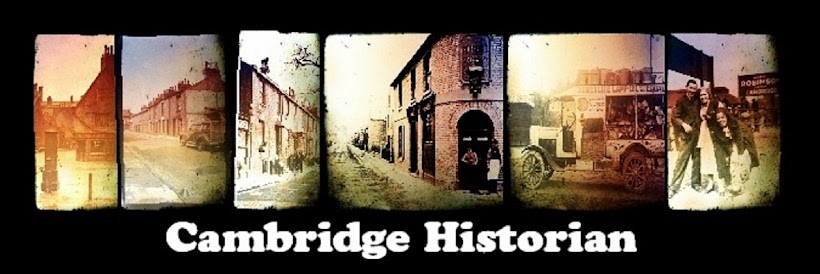Below is details about some of those attacks on Cambridge from 1940 - 1942.
If you study the history of air raids on Cambridge you will discover the first devastating air attack took place on Vicarage Terrace in June 1940, but few people, even now, are aware that about 10 weeks before the Vicarage Terrace attack 11 H.E bombs were aimed at Cambridge, but fell in sugar beet fields on the outskirts of the city, only causing damage to the crops.
 |
| The Vicarage Terrace Attack |
On the 28th August a total of eight bombs fell on Cambridge again ( One failing to go off), there were again a large number of people who escaped the attack. The unexploded bomb fell a few feet from a house at the top of Leys Avenue, there was slight damage to the property, but the people inside went unharmed. Some other bombs fell in Pemberton Terrace and Shaftesbury Avenue.
On the 15th October one person was killed when a single bomb hit a house in Barrow Road.
It was during the next year, 1941, Cambridge saw the worse year for bombing.
On the 16th January, a cold icy night, 200 incendiary bombs, most of them in the area of Hyde Park Corner were dropped on the city. Perse School was severely damaged by fire, while a warehouse nearby in Regent Street, also suffered damage. Firemen were hampered by hydrants either buried in the snow or found they got frozen up.
On the 30th January at four o'clock in the afternoon attacks were made in the Mill Road bridge area, where two small cottages were hit at the side of the bridge. Two people lost their lives and ten others were injured.
On the 15th February a bomb fell in front of a house in Cherry Hinton Road, The porch was blown apart, but all eight people inside escaped unhurt.
On the 24th February the city suffered a attack that resulted in the death of eleven people, including wardens and firewatchers on duty. This attack was carried out in three phases.
The attack started with incendiaries being dropped in the Cherry Hinton Road area at about 10pm. At 10:35pm two H.E's made a direct hit on a house at Grantchester Meadows, killing two woman. At 11.15 a whole batch of H.E's and a score of incendiaries fell on Hills Road between Hyde Park Corner and Station Road. Wardens and firewatchers were caught up in the attacks, while others were injured in their homes.
On the 9th May a more determined attack happened with fire bombs. Hundreds of incendiaries were showed in the area between Hills Road and Trumpington Road. Fifty houses received direct hits, yet all but four or five of the resulting fires were put out within minutes.
On the 29th August Romsey Town was the scene of a serious attack. 10 H.E bombs, presumably aimed at the railway, hit two houses in Great Eastern Street, causing two deaths and injuries to seven people.
On the 29th September on a wet evening at about 11 o'clock incendiaries hit Huntingdon Road, just beyond the top of Castle Hill. Extensive damage was caused to telephone wires and public service pipes, but luckily there was no traffic about and nobody was in the road at the time, or they would not have survived.
Ten months elapsed before the next air raid.
On the 28th July 1942 when the bombing started again, it was on a sharp scale. A single low-flying raider, clearly visible in the moonlight, attacked Bridge Street and Sidney Street with eleven H.E's and many incendiaries. It was with this attack that the Germans are said to have made use of their new explosive incendiary bombs, one of which caused the big fire at the Union Society building. As the result of this attack three people were killed and seven injured; 10 buildings were destroyed or rendered unsafe so they had to be demolished, and another 127 properties were damaged to a much lesser extent.
The results of the attacks would of been much worse but for the fact that three of the H.E's failed to explode. One of the bombs went through a roof of a house in Portugal Place and rested just above the basement where the residents were sheltering. One lodger who was still in bed awoke to see the bomb sticking through the wall.
These article may also be of interest: The Bombing of Vicarage Terrace
The Cambridge Evacuee's

